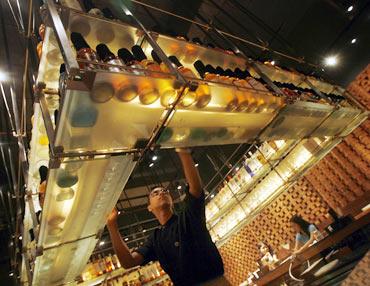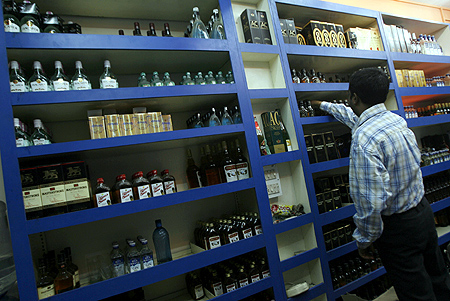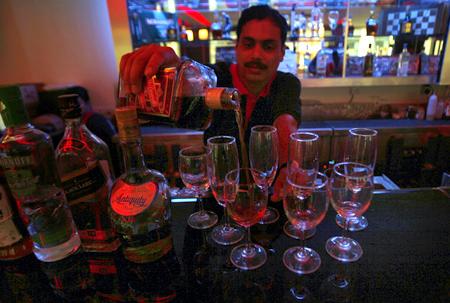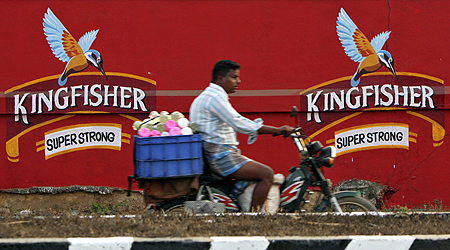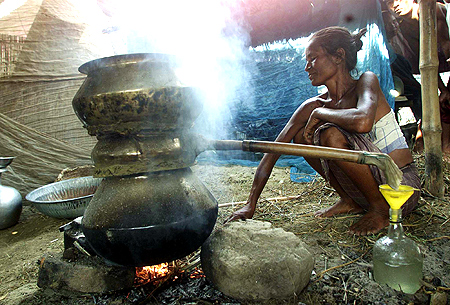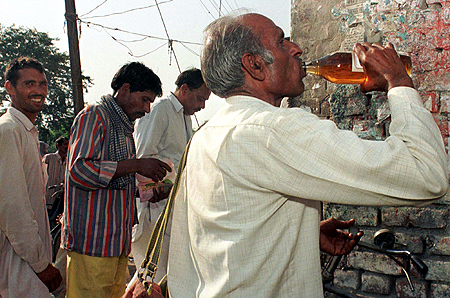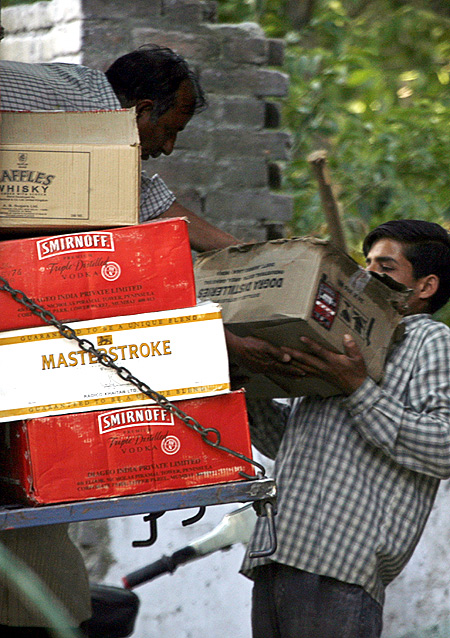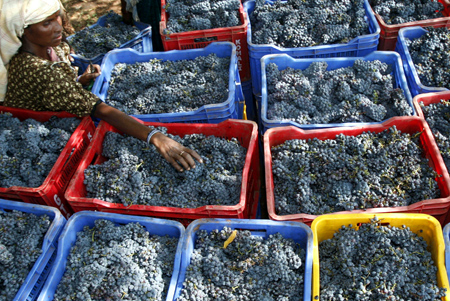 | « Back to article | Print this article |
The truth behind Andhra's liquor scam
Price-gouging retailers are being blamed for soaring liquor prices in Andhra Pradesh. The real culprit however lurks elsewhere, say critics.
In a departure from the usual refrain on government failure in containing inflation, opposition leader N Chandrababu Naidu last year promised on more than one occasion that he would bring down the prices of liquor if voted back to power in 2014.
That was when a Rs 70-beer bottle was being sold at Rs 120-plus.
Click NEXT to read further. . .
The truth behind Andhra's liquor scam
Then, in February, the government, headed by N Kiran Kumar Reddy, went ahead and initiated a widespread crackdown on the so-called liquor syndicates (local cartels of retailers).
Notwithstanding some conspiracy theories, the scale of the operation against liquor traders made many to believe that what was at stake here was not just the interests of those who consume liquor.
They may be right.
The crusade against the liquor cartel may well be masking another dynamic that many say is the real reason behind the spike in liquor prices -- namely, exorbitant liquor licence fees paid to the government by retailers.
Click NEXT to read further. . .
The truth behind Andhra's liquor scam
First a recap: The grounds for this unusually massive operation by the Anti Corruption Bureau, which is under the direct administrative control of chief minister Reddy, is that most of the 6,596 shops (retail licensees) in the state were selling liquor at prices above the MRP fixed by the government.
The ongoing ACB probe revealed the nexus between liquor syndicates, government officials and the politicians in perpetuating the MRP violation among other irregularities.
In a letter to the excise commissioner in November, 2011, the AP Wineries and Distilleries Association, which represents liquor manufacturers who supply in bulk to Andhra Pradesh Beverages Corporation, alleged that the retail shops were selling at a margin of 100 per cent on the price available to them at APBCL point.
AP State Wine Dealers Association general secretary D Venkateshwar Rao admits that the retailers were selling liquor at anywhere between 30 and 40 per cent in excess of the MRP.
Click NEXT to read further. . .
The truth behind Andhra's liquor scam
Yet, they were doing so, according to D Venkateshwar Rao, simply to recover the immense costs of the licence fees.
The proof, most critics say, is in the math.
Simple math
In the tender process (auction) to grant retail licences for the two year period (2010-12, excise year July-June), the excise department collected Rs 7,000 crore (Rs 70 billion) from successful bidders towards the licence fee, which became one more important source of revenue for the government in addition to a variety of taxes levied on liquor.
Click NEXT to read further. . .
The truth behind Andhra's liquor scam
Selling liquor at above MRP now makes sense when the total licence fee collected is divided by two to know how much all the 6,500-odd retailers were paying to the government each year to earn a legitimate retail margin of around Rs 3,217 crore (Rs 32.17 billion) on sale value of Rs 13,406 crore (Rs 134.06 billion) in 2010-11 -- namely Rs 3,500 crore (Rs 35 billion) -- putting retailers at an immediate loss.
As a consequence, consumers were being charged abnormal premiums at retail shops. Also, the sale of non-duty paid liquor and ID liquor became rampant in the state, as the investigation reveals.
"We should not equate corruption with liquor and all this MRP talk is a popular rhetoric. "The real issue is that the government had started depending on liquor for revenues.
As a consequence, we already have belt shops (village sub-outlets) 15-20 times over that of retail licences.
Click NEXT to read further. . .
The truth behind Andhra's liquor scam
"People are initiated into drinking at an early age of 15," Jayaprakash Narayan, president of Lok Satta party and member of the Andhra Pradesh legislative Assembly, says.
This year up to January 2012, the government collected over Rs 20,000 crore (Rs 200 billion) from liquor sales, according to him.
Liquor is one of the single largest revenue earner for the state -- it contributes 20 per cent in terms of sales tax, next only to petroleum products that comprise 25 per cent of the total VAT collections.
These two commodities largely insulate the state exchequer from the vagaries of the general economy.
Click NEXT to read further. . .
The truth behind Andhra's liquor scam
In simple terms, for every Rs 100 of liquor, a manufacturer/supplier gets Rs 24 and the government gets Rs 76.
The retailer's margin and the licence fee come on top of that. Value of liquor sales at the APBCL point for the year 2011-12 were about Rs 14,847 crore (Rs 148.47 billion).
Total turnover is difficult to gauge because it depends on how much retail margin has to be included.
Meanwhile, liquor manufacturers were of the view that the volumes were either not growing at the pace they should be or remained almost stagnant (especially IML sales) since 2010 because of high prices.
Click NEXT to read further. . .
The truth behind Andhra's liquor scam
"AP used to be next to Maharashtra in terms of liquor volumes after lifting prohibition.
"Just four years ago we were ahead of Tamil Nadu, which has overtaken Andhra since then," says B Purnayya, management consultant, who has been associated with the liquor industry for the past 30 years.
Here's the catch: The last time a direct correlation was observed between the growth in value of sales (at the APBCL point) and the growth in volumes, was in the year 2006-07 when the sales value grew 25.67 per cent at Rs 6,740.55 crore (Rs 67.4 billion) and the volumes grew 26.39 per cent at 56.58 million cases (IML+beer, each case contains 12 bottles).
Click NEXT to read further. . .
The truth behind Andhra's liquor scam
This correlation got more tenuous in the next three years and almost disappeared in the year 2009-10 during when value of sales grew 18.5 per cent at Rs 11,771.34 crore (Rs 117.71 billion) as compared to just 0.67 per cent increase in volumes at 66.25 million cases.
It shows that the government has been pushing the sector for more revenues year after year even while the volumes were not justifying the government's revenue targets.
Now, say critics, the main question is who is actually fleecing customers in Andhra more -- the government or liquor retailers?
